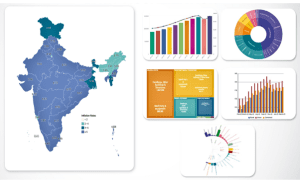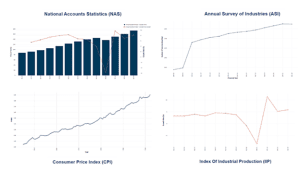TAG: GS 2: GOVERNANCE
THE CONTEXT: e-Sankhyiki, a national statistics office data portal, has been launched. This new platform is a comprehensive and user-friendly resource for reliable data, offering easy access and efficient management at the click of a mouse.
EXPLANATION:
- With the mandate to ensure the availability and accessibility of quality data, it is ensured that every citizen, researcher and policymaker has access to accurate and reliable information.
- In today’s age, data is the cornerstone of decision-making, driving innovation, efficiency, and growth across all sectors by providing critical insights and enabling informed choices.
- Under Government of India, the Ministry of Statistics and Programme Implementation (MoSPI) is the backbone of the country’s data ecosystem. MoSPI is dedicated to generating and disseminating official statistics.
e-Sankhyiki
- Launched on National Statistics Day 2024, the e-Sankhyiki portal is designed to create a comprehensive system for managing and sharing data, facilitating the easy dissemination of official statistics across the country.
- It aims to provide timely and valuable data inputs for policymakers, researchers, and the general public.
- It provides time series data for key macroeconomic indicators, with features for filtering and visualising the data.
- Users can also download customised datasets and visualisations and access them through APIs, enhancing the data’s reusability.
Key Modules of e-Sankhyiki
- The e-Sankhyiki Portal comprises two modules designed to facilitate easy access and re-use of data.
- Data Catalogue Module
- This module catalogues the Ministry’s major data assets, simplifying users’ access.
- It enables searching within datasets and tables, downloading relevant data, and enhancing its value and reusability.

- The Data Catalogue includes seven core data products:
- Consumer Price Index,
- Index of Industrial Production,
- National Accounts Statistics,
- Periodic Labour Force Survey,
- Annual Survey of Industries,
- Household Consumption Expenditure Survey, and
- Multiple Indicator Survey.
- It currently hosts over 2,300 datasets, each accompanied by specific metadata and visualisations for user convenience.
- Macro Indicators Module
- This module provides time series data on key macro indicators, featuring tools for filtering and visualising data.

- It allows users to download custom datasets, generate visualisations, and share data through APIs, promoting greater reusability.
- The initial phase of this module covering data from the past decade includes four major MoSPI products:
- National Accounts Statistics,
- Consumer Price Index,
- Index of Industrial Production, and
- Annual Survey of Industries

- The portal currently features over 1.7 million records, providing access to extensive vital data.
Government Initiatives for Safe Data Dissemination
- In response to the rapid data expansion, the Government of India has instituted robust data safety measures.
- These include storing data in the cloud facilities provided by the National Informatics Centre (NIC), conducting comprehensive security audits of applications, and implementing Secure Sockets Layer (SSL) technology for domain protection.
- Additionally, the government has focused on vulnerability assessments and ensured compliance with guidelines issued by organisations such as NIC and the Indian Computer Emergency Response Team (CERT-In).
- The NIC is integral to these efforts, offering advanced ICT infrastructure and services to various government entities, including Central and State Governments, Union Territories, and District administrations.
- Its extensive services include multi-gigabit nationwide networks (NICNET and NKN), National Data Centres, National Cloud, nationwide video conferencing infrastructure, Command and Control Centres, a multi-layered GIS platform, domain registration, and webcast services.
- These capabilities are crucial for delivering efficient, citizen-centric e-services throughout the country.
- Further, under the Ministry of Electronics and Information Technology (MeitY), CERT-In engages in several critical activities to enhance data safety.
- These include issuing advisories and cyber and information security guidelines and conducting sensitisation programs, training sessions, and workshops.
- CERT-In also operates the Cyber Threat Exchange platform and the Cyber Swachhta Kendra, formulates the Cyber Crisis Management Plan, establishes the National Cyber Coordination Centre (NCCC), and manages the empanelment of security auditing organisations.
Indian Computer Emergency Response Team (CERT-In)
- It is the national nodal agency for responding to computer security incidents as and when they occur.
- It is a functional organisation of the Ministry of Information & Electronics Technology, Government of India, with the objective of securing Indian cyberspace.
- CERT-In has been operational since January 2004.
- The constituency of CERT-In is the Indian cyber community and Indian cyberspace.
SOURCE: https://www.pib.gov.in/PressNoteDetails.aspx?NoteId=151992&ModuleId=3
Spread the Word
